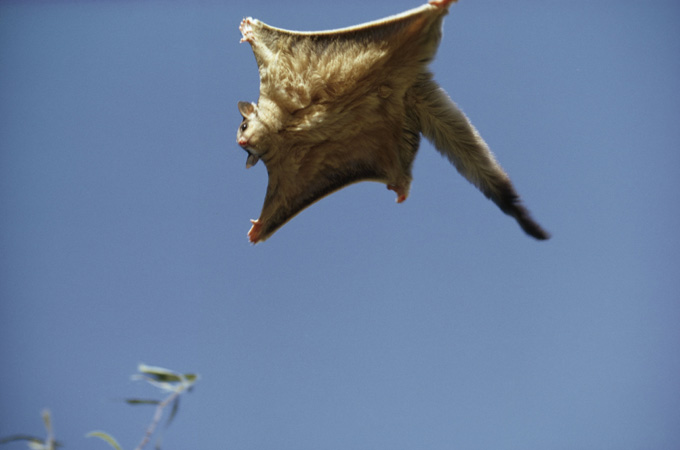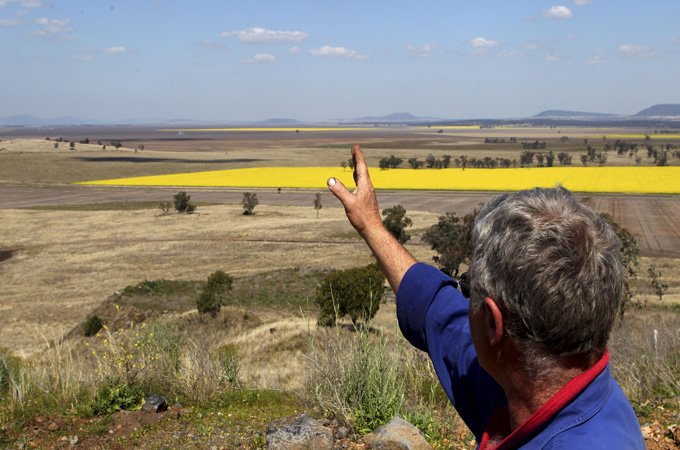Blockading Australia’s largest coal mine
Protesters angry over the bulldozing of 1,500 hectares of a unique and endangered ecosystem for an open-pit coal mine.

Maules Creek, Australia – On a balmy Sunday in late November, the renowned Rugby Union Wallabies player David Pocock chained himself to mining equipment where he spent the next 10 hours with a handful of others to protest against the bulldozing of a state forest to make way for what will become Australia’s biggest coal mine.
In a photo posted to his Twitter account, Pocock is seen smiling and wearing a wide-brim hat, while tethered with a farmer to a super-digger near the Maules Creek mine, located in the coal-rich Gunnedah Basin of New South Wales.
Keep reading
list of 4 itemsAfter the Hurricane
World’s coral reefs face global bleaching crisis
Why is Germany maintaining economic ties with China?
Construction of the open mine, which will cost an estimated AUS $670m ($558m), according to Whitehaven Coal, started in January 2014. Since then, blockades and protests have regularly sprung up with activists chaining themselves to mining equipment and creating roadblocks in and around the mine.
 |
| The squirrel glider is one of 34 threatened species that live in Leard State Forest, 1,500 hectares of which will be bulldozed to make room for a new mine [Getty Images] |
They’re angry at the creation of a mine that requires the bulldozing of about 1,500 of the 8,000 hectares of Leard State Forest. It’s a unique and endangered ecosystem that is home to 396 native species of plants and animals, of which 34 threatened species live including the squirrel glider.
The mine was approved in July 2013 by the state government, and the life of the project is expected to span over three decades with an estimated 13 million tonnes of coal produced annually, once production reaches full capacity.
It is also one of the last areas of Australia’s nationally listed and critically endangered Box-Gum Woodland and a sacred site for the traditional owners of the land, the Gomeroi people.
In a statement posted on his personal blog, Pocock said people were resorting to non-violent direct action all around the world to highlight the deep inequalities represented by climate change.
“In Australia, we are faced with retreat from action on climate change and a clear commitment from our government to expand the fossil fuel industry – how can we possibly prevent catastrophic climate change while opening new coal mines?” he wrote.
How can we possibly prevent catastrophic climate change while opening new coal mines?
Pressuring a farmland ‘food bowl’
The Liverpool Plains cover a 1.2 million hectare area, and is known as a food bowl, producing enough grain for 365 million loaves of bread, 62.5 million packets of pasta and 58 million boxes of cornflakes each year, according to the Permaculture Research Institute.
Farmers use the land to produce wheat, maize, barley, vegetables including peas and beans, and cotton, and grazing for sheep and cows.
“It’s very much a wait and see thing at the moment,” farmer Rick Laird said.
Leard State Forest is named after the Laird family, one of the oldest farming families in Maules Creek.
Fifth generation farmer Laird, who was arrested with Pocock last week, said people are worried about the health impacts of the mine from dust and noise, which in turn will make properties at risk of plummeting values.
According to Front Line, the Maules Creek mine has been allocated 50 percent of the high security water from Namoi River, which is a main source of water supply for surrounding farmlands. Farmers and residents are concerned about the falling levels in the area’s water table, as the mine taps into local resources already hard pressed by drought and the beginning of an unusually warm summer.
“Water is the most valuable thing,” said Cliff Wallace, a lifelong farmer in Maules Creek and a campaigner against the mine. “The problems are going to sneak on us over a period of time.”
“A lot of us are pissed off at Whitehaven, there’s no question about that.”
“The area doesn’t have a lot of surface water, it’s reliant on this underground water for irrigation – it’s going to have a severe impact on an area with drought like conditions,” Phil Evans, Leard Forest Alliance’s spokesperson told Al Jazeera by phone.
Sacred sites
For the traditional owners of the land, the Gomeroi people, Maules Creek holds a deep cultural and spiritual significance.
“We believe they are sacred areas and no amount of money was going to make us sign off on them,” Dolly Talbot, a Gomeroi woman told Al Jazeera.
 |
| The Liverpool Plains cover a 1.2 million hectare area, and is known as a food bowl, producing enough grain for 365 million loaves of bread, 62.5 million packets of pasta and 58 million boxes of cornflakes each year [AP] |
The traditional custodians of the land, the Gomeroi people have been unable to access parts of Maules Creek to perform healing ceremonies in areas that have been desecrated.
“Because we wouldn’t sign off on sites that we believe are sacred areas, Whitehaven have got other people to sign off on them, Gomeroi people but not of the same clans, they don’t have the same connections.”
Talbot says members of the Gomeroi community have contacted government departments, relevant authorities and Whitehaven, and a formal complaint is now before the New South Wales’ Anti-Discrimination Board.
“We need to go in there and heal the land and heal some of this experience with elders and the rest of the community,” she said.
In a report, the not-for-profit organisation Greenpeace said Whitehaven had “failed to allow access to Gomeroi burial and other sacred sites for ceremony”.
“We’ve got great indigenous cultural heritage being destroyed, so the Gomeroi traditional custodians are very traumatised by this project,” said Nick Clyde, a senior climate campaigner with Greenpeace.
Unlikely alliances
When contacted, a spokesperson for Whitehaven Coal provided Al Jazeera with several fact sheets on the mine and a brief statement.
“Maules Creek has been thoroughly assessed and fully approved by all relevant state and federal government authorities,” a spokesperson said, while a fact sheet said the mine is “fully permitted with first class and comprehensive mine rehabilitation management and no legacy environmental issues”.
In an environment assessment report, the NSW Department of Planning and Environment said risk assessments were undertaken to identify potential environment and social issues associated with the project and that the mine plan avoided the disturbance of over 100 hectares of critically endangered ecological community.
A Biodiversity Offset Strategy was announced that “aims to maintain and then improve the biodiversity values of the landscape in the medium to long term through restoration and conservation of land”.
In a united front, farmers, indigenous custodians and environmentalists have formed an unlikely alliance.
“The department understands Whitehaven has offered the local Aboriginal community, including the Gomeroi Traditional Custodians, the opportunity to access the site to undertake cultural ceremonies,” it said.
In an emailed statement, the NSW Department of Planning and Environment said the project underwent an extensive assessment process involving public hearings, and considered all of the potential impacts including dust, noise, water and Aboriginal cultural heritage.
Aboriginal sites predicted to be disturbed would be salvaged and management would be done in consultation with Aboriginal stakeholders, the report said.
“Farmers who you might say their forebears had dispossessed Aboriginal people originally have signed a heritage and environment protection agreement with the traditional custodians and with green groups,” said Greenpeace’s Clyde.
“These kind of alliances are happening in a way that they did not before.”
Whitehaven is restricted to clearing the forest between February 15 and April 30, 2015 and is expected to start shipping coal in the first quarter of 2015.
Pocock will appear in Narrabri Local Court on January 14.